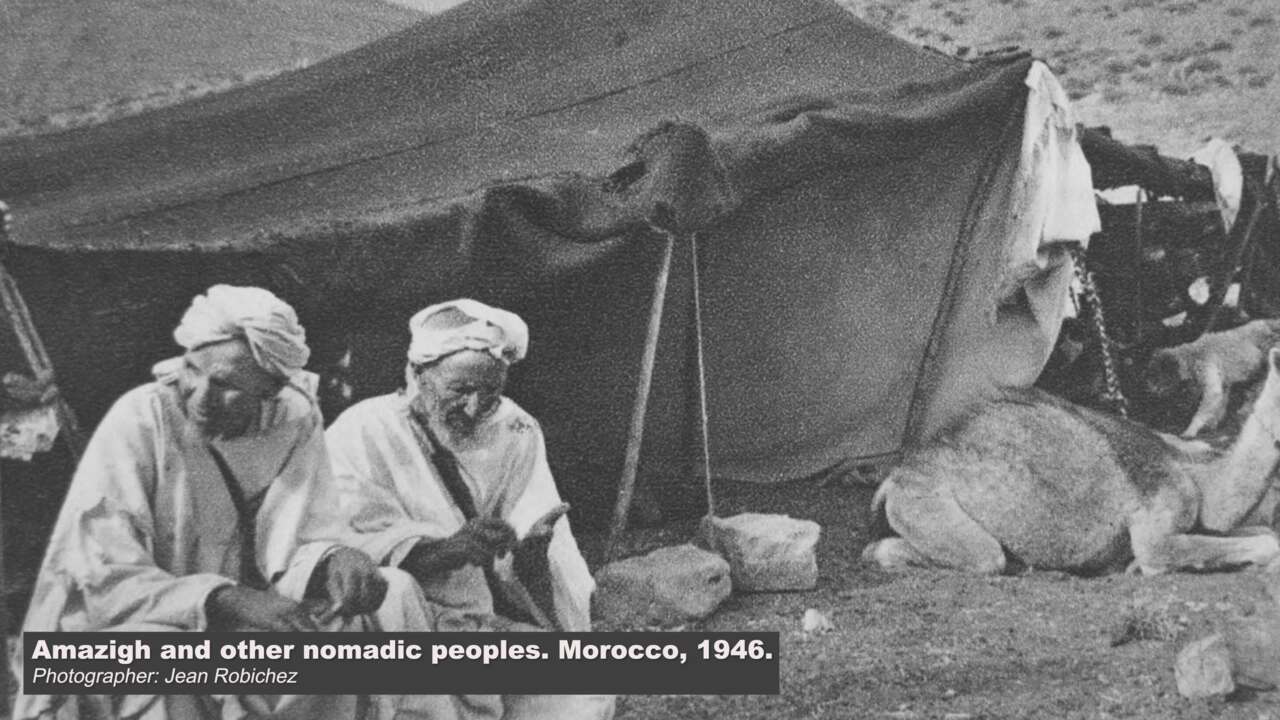[MUSIC PLAYING]
[NON-ENGLISH SPEECH]
I have seen hatred flourish in the country of the Nazis and a whole nation endure the caustic, corrosive acid thrown at them, like a cruel joke, by the speeches of an insane, vulgar buffoon, this pernicious clown seized by fury, preaching denunciation, murder and violence. Despite my indifference, I felt my face flush and turn bright red from shame and disgust. In my feeble hands, the whip of satire is too clumsy to excoriate Hitler. At least, it expresses my complete aversion. And that is why reader, though I may displease you in order to release my sorrow and to cry out my anger, I offer you this text filled with indignation.
[MUSIC PLAYING]
When we think about the writing of Holocaust history in general, it has tended to overlook the stories of North African Jews and descendants of North African Jews who were caught in the Nazi dragnet and who were deported to internment and death camps, who were survivors, who were victims, who were resisters, who were partisans, who occupied all of the complex niches and experienced all of the histories that European Jewry in general experienced. So there, I refer mostly to North African Jews living in Europe and their children who might have been born in Europe, but born the children of immigrants.
If we turn to North Africa itself, there was not a systematic policy of deporting Jews from North Africa or Muslims from North Africa to the camps, except for the Italian case, where the fascist regime deported Jews to concentration camps in Italy. And some of them did end up in the Nazi death camps. But all told, this variety, tremendous variety of histories, has been written out of Holocaust history.
[MUSIC PLAYING]
It is also true that if we look at the history of North Africa, whether we look at historical accounts that focus on Jews, or whether we look at regional historical accounts, there too, the Second World War, until very recently, has been a chapter that has been avoided, I would say. Not forgotten, but avoided for a range of reasons that, Omar, you might want to speak about. So whether it's Holocaust history, whether it's Jewish history, whether it's North African history, there are various reasons that these histories have been silenced.
[MUSIC PLAYING]
So one of the things that, for me, to think about the silence is the voice of local histories. And the voices, these voices are generally-- when you look at textbooks-- or to pick up a history textbook, for instance, in Morocco, or history textbooks in Algeria, or in Tunisia, how much of it is about long histories of Judaism in that region, which goes back to the pre-Islamic period? So that's very scant. We have a very limited information.
So in order to really complicate, but also describe and inform us about what happened to these communities, Muslim, Jewish, Arabs, Christian, Amazigh, all of these different ethnic and religious group, the idea and the responsibility for us as educators and as historians is to really write down those stories. And then we can get to putting them together in conversation with what's happening-- what happened in Europe.
[MUSIC PLAYING]
This geographic region we call North Africa, we call it also the Maghreb, the region that was inhabited originally by an indigenous group called the Amazigh, which has always been known in the literature as Berbers. But it's a pejorative term, so the indigenous people prefer the word Amazigh. There are different groups of Amazigh all over North Africa, from Libya to Tunisia to Morocco to Algeria. They speak different dialects, different Amazigh dialect. These are the indigenous populations.
And then on top of that Indigenous population, you start seeing the flow of people coming from the eastern part, from Palestine, from the Holy Land, from Iraq, Mesopotamia, Egypt. And then you have another flow of people come in from the south, from Sub-Saharan Africa and the rest of Africa. And then you get a mixing, more mixing of population, of ethnicities, and the groups and their cultures.
Judaism arrives to that region, going back to the destruction. We have stories that talk about the destruction, in all history, talks about the destruction of the first temple. We don't have proof. They will have stories that discuss the arrival of Judaism to the destruction of the second temple. But we do know that the majority of Jewish settlements in that region came before Islam.
And then they mixed with the local population, with the Amazigh. So that's why we talk about Amazighs, who are Amazighs basically, not only adopted other religion-- animism, for instance-- and believed in idols and so on and so forth. But they also became Jews before they were Christians, before they became Muslims. So we have-- some of the early believers in Judaism are the Amazigh. And then with the coming of Islam, with Arab population coming from the rest of the heartland of the Middle East, the Arabian Peninsula, with the Islamic conquest and the Islamic move to the western part to North Africa, you start seeing more and more, a conversion from Judaism, Christianity, to Islam.
But still, the majority of North Africans who retained Judaism was rooted in this part. Even though at a certain moment in the history of North Africa, you have certain dynasties who tried to expel Jews. We have one of the dominant cases, a dynasty called the Almohad dynasty, who tried basically to force Jews either to convert or leave. But in general, while Christianity ended in North Africa as one of the main religions, Judaism survived.
Now, you have another wave of Jewish migration that came, that arrived to North Africa, which is after the Inquisition. So here, we're talking about what we call the indigenous groups, the older, which are the Toshavim, the oldest one. And then you have the Megorashim, the ones who came after 1492. And that really-- what you have-- that led to the development of a different conversation between the two Judaisms. And the one that came from Muslim Spain, after they ended up actually winning that war, especially in terms of how it became part of-- what represents Judaism in general.
[MUSIC PLAYING]
I think what's crucial to emphasize, before we get to the era of colonialism and before we get to the era of the Holocaust, is that this is a region marked by diversity. You could say that the same holds true for European Jewry. More is known of the kinds of differences, of language, of religious practice, of class, of urban and rural that define European Jewry. But there are echoes of this that of course took different form all across North Africa.
There are urban Jews. There are coastal Jews. There are rural Jews. There are mountain Jews. There are Saharan Jews. There are wealthier, there are poorer. There are those who live in close proximity to power and those who live quite far from the reach of local or state authority, speakers of different languages, practitioners of different Jewish religious rites, different culinary traditions, different sartorial traditions.
So the first thing, I think, we have to have in mind is that we make a mistake if we speak about North African Jewry as a singular phenomenon. This is a region of difference. These are cultures of difference. And these differences. Through the era of colonialism and into the era of the Second World War, will fundamentally define individuals' experiences during the war years.
[MUSIC PLAYING]














